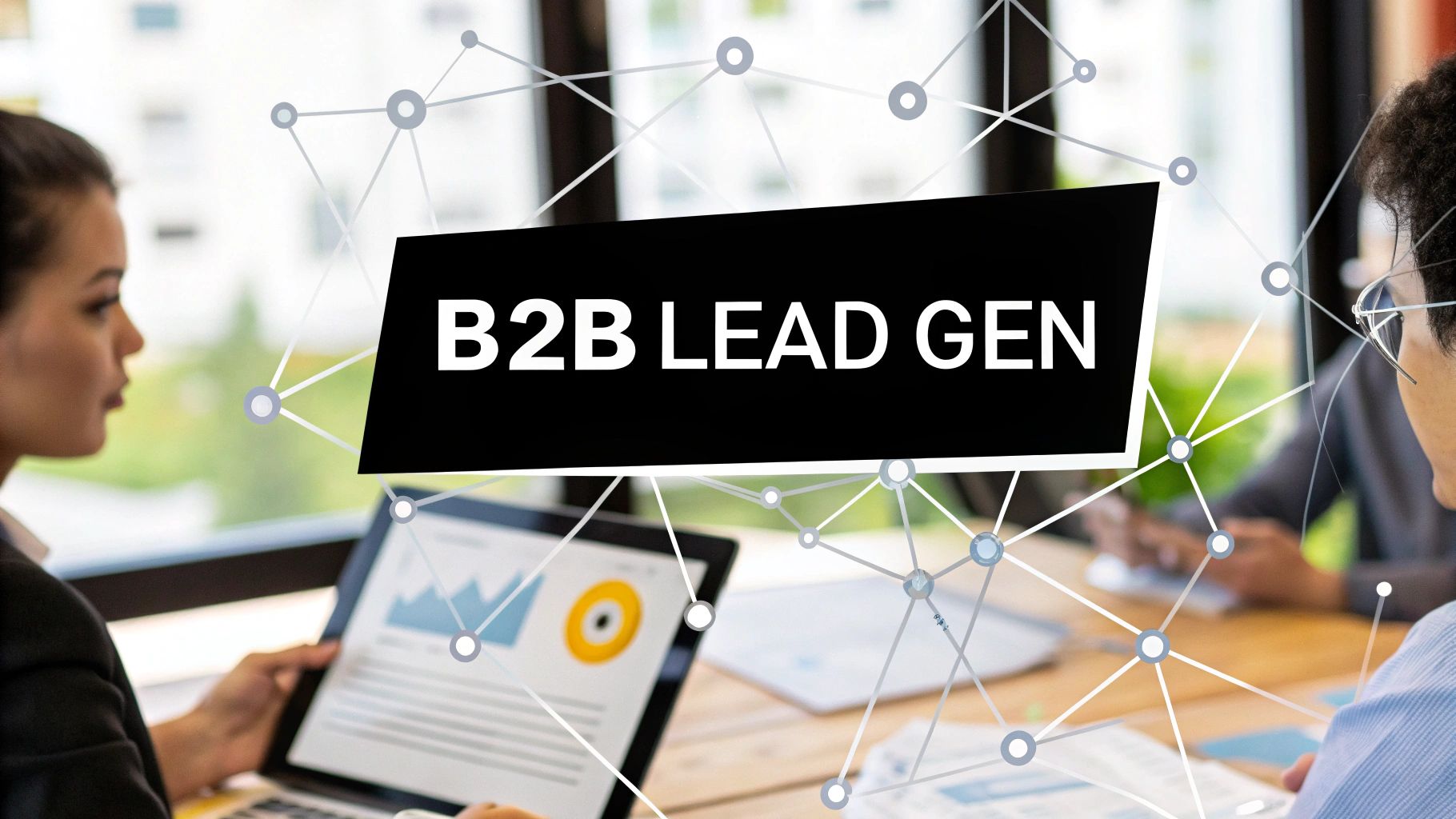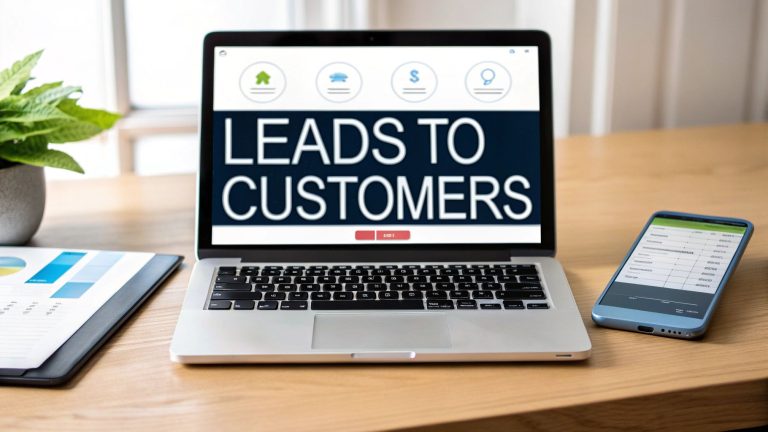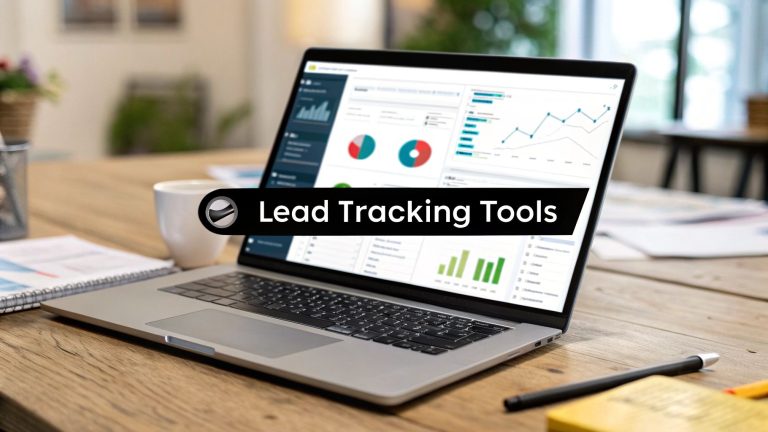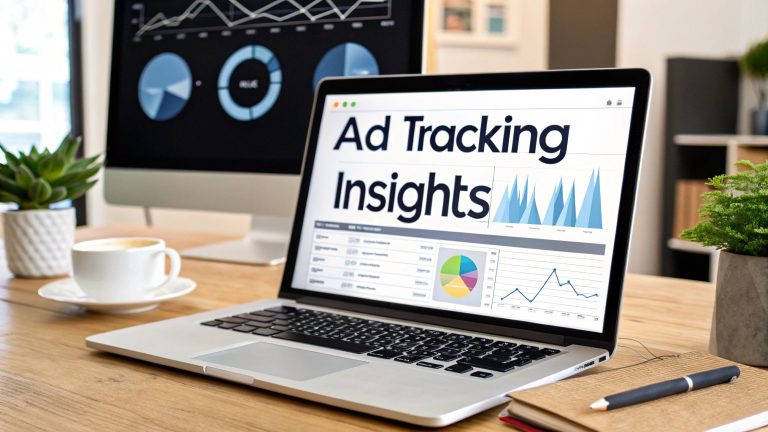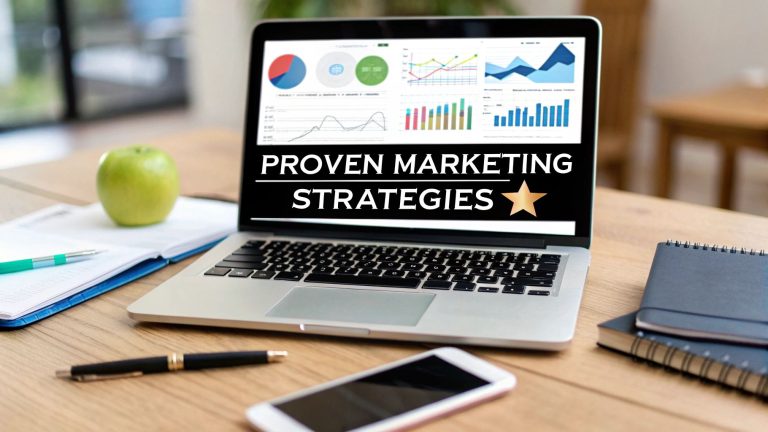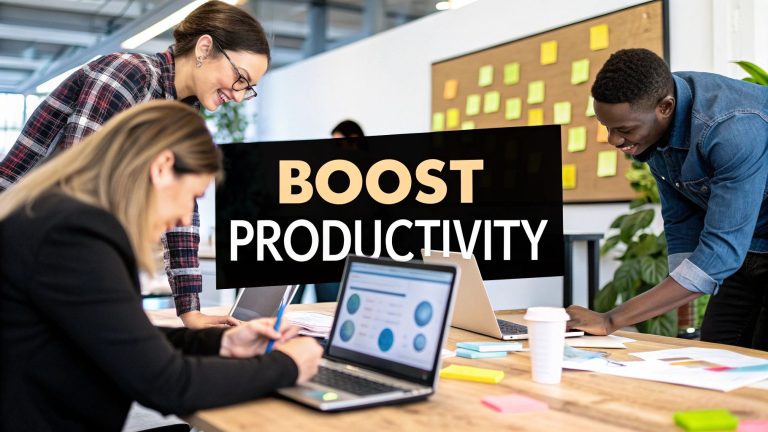What Is B2B Lead Generation Your Practical Guide
So, what exactly is B2B lead generation?
Think of it as the starting point for every B2B sale you’ll ever make. It's the whole process of finding and grabbing the attention of businesses that could be perfect customers for whatever you're selling. It’s the very first, and most critical, step in building a healthy sales pipeline.
The Engine of Business Growth
Let's use an analogy. If your business is a high-performance car and sales are the fuel, B2B lead generation is the engine itself. It's the powerful, complex system that turns raw potential into real forward momentum.
Without a strong engine, your business is just sitting in the driveway, no matter how much fuel you pour into the tank. Lead generation is the strategic work of figuring out which companies truly need what you offer and then warming them up until they’re actually ready to talk to a salesperson.
This isn't just about scooping up a list of contacts. It’s about building a predictable, repeatable system for bringing in potential clients. To get a feel for what works, you can explore these proven B2B lead generation strategies. The goal isn't just to get more leads; it's to get the right leads.
Why Quality Over Quantity Is Everything
Chasing low-quality leads is like trying to run your car's engine on watered-down fuel. You might sputter forward a bit, but you won't get far before stalling out.
In the B2B world, sales cycles are long and often involve a whole committee of decision-makers. That's why getting the right companies in the door from day one is non-negotiable. A truly qualified lead is a business that ticks three critical boxes:
- They have a genuine need for your product or service.
- They have the budget to actually buy it.
- Someone in the conversation has the authority to sign off on the purchase.
When you focus on these criteria, you stop wasting your sales team's time. They get to spend their energy on opportunities that have a real shot at closing, which is how you maximize your ROI.
"B2B lead generation isn't just about cramming prospects into the top of your funnel. It's about filling it with the right prospects—the ones who are highly likely to become valuable, long-term customers."
Before we dive deeper, let's break down the core elements involved.
Key Components of B2B Lead Generation
This table outlines the fundamental parts of a solid B2B lead generation process, showing how each piece contributes to the end goal.
| Component | Description | Primary Goal |
|---|---|---|
| Lead Magnet | A valuable resource (e.g., ebook, webinar, free trial) offered in exchange for contact information. | Attract interest from potential customers by solving a specific problem for them. |
| Landing Page | A dedicated web page with a form designed specifically to capture lead information for the lead magnet. | Convert visitors into leads by making it easy and compelling to sign up. |
| Lead Nurturing | A series of automated communications (usually email) designed to build a relationship with the lead over time. | Guide the lead through the buyer's journey and keep your business top-of-mind. |
| Lead Scoring | A system for ranking leads based on their engagement, firmographics, and fit with your ideal customer profile. | Prioritize the hottest leads for the sales team to follow up with immediately. |
| Sales Handoff | The process of passing a marketing-qualified lead (MQL) over to the sales team to become a sales-qualified lead (SQL). | Ensure a smooth transition from marketing to sales for a seamless customer experience. |
Each of these components plays a vital role in creating a machine that consistently delivers high-quality opportunities to your sales team.
The Financial Impact of Getting It Right
The numbers don't lie—this is a high-stakes game. On average, companies generate around 1,877 leads per month. But with the average cost per lead hovering at $198.44, the investment is significant.
Without a smart, refined strategy, you can burn through your budget incredibly fast with very little to show for it. Ultimately, a strong B2B lead generation process is the foundation for all your sales activities. It directly drives revenue, builds your pipeline, and positions your brand as a go-to authority in your industry.
Navigating The B2B Sales Funnel
So, what happens after you've identified a potential business customer? You can't just jump straight to a sales pitch. You need to guide them.
Think of the B2B sales funnel as a journey you map out for your prospects. It's a structured path designed to turn a curious stranger who might have a problem into a loyal client who trusts your solution. It’s not a single event; it's a process. Each stage requires a different kind of conversation to meet the buyer where they are.
We call it a funnel because you start by attracting a wide audience of potential fits, and then, as you learn more about them (and they learn more about you), you gradually filter down to the most serious, ready-to-buy opportunities. Understanding this flow is the key to turning interest into actual revenue.
The Top of The Funnel (ToFu): The Awareness Stage
At the top of the funnel, or ToFu, your goal is simple: get on their radar. You're not selling anything yet. You're educating.
You're casting a wide net to attract any business that might be experiencing the problems you solve, even if they've never heard of your brand. The key is to be helpful, not pushy.
Content at this stage needs to be valuable and easy to find, focusing on answering common questions and addressing industry pain points.
- Blog Posts: Articles that break down common challenges or trends.
- Social Media Updates: Shareable, engaging content that builds your brand's presence.
- Infographics: Visually digestible data that makes complex ideas simple.
This infographic gives a great overview of the entire lead generation flow, from initial contact to the final conversion.
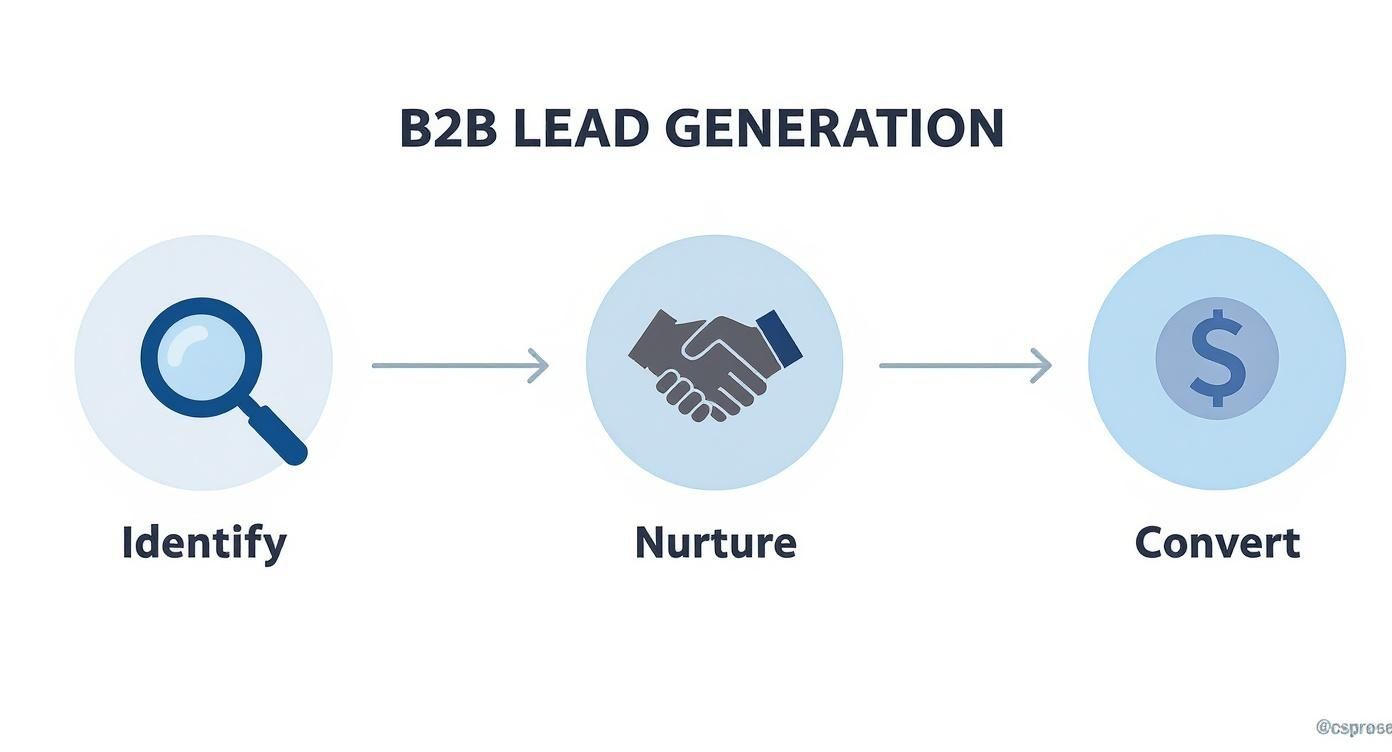
As you can see, it's a multi-step game that requires patience and a solid strategy.
The Middle of The Funnel (MoFu): The Consideration Stage
Okay, so a prospect has read your blog post or downloaded an infographic. They've moved into the middle of the funnel (MoFu). Now they're aware they have a problem and are actively looking for the best way to solve it.
Your job here is to build trust and position your company as the go-to expert. You need to show them you have the answers they're looking for.
Content in the middle is more detailed. It’s for prospects who want to dig deeper and evaluate their options. Think in-depth webinars, detailed case studies that show real-world results, and expert guides that prove you know your stuff inside and out.
This is where the crucial handoff from marketing to sales often begins. When a lead shows consistent interest—maybe they attended a webinar or downloaded a case study—they become a Marketing Qualified Lead (MQL). They're officially on the "warm leads" list.
The Bottom of The Funnel (BoFu): The Decision Stage
Welcome to the bottom of the funnel, or BoFu. The leads who make it here are ready to pull the trigger. They’ve done their homework, they've compared vendors, and now they're just trying to make the final call.
Your goal is to make their decision easy by showing them exactly how you'll solve their problem and making a clear, compelling offer.
This is where the sales team really shines. They take that MQL from marketing, vet them, and if they check all the right boxes—like having the budget, authority, and a pressing need—that lead graduates to a Sales Qualified Lead (SQL).
Activities here are highly personalized: one-on-one product demos, free trials, and customized proposals. This is the final push that turns a well-nurtured relationship into a brand-new customer.
Mastering Inbound Lead Generation Strategies
Forget the old playbook of shouting at potential customers. Unlike outbound marketing, which pushes messages out, inbound is all about pulling your ideal clients in. Think of it like a magnet. You create and share genuinely helpful content that solves real problems, naturally attracting qualified prospects who are already looking for answers.
Instead of interrupting their day with a cold call, you earn their attention. When a decision-maker stumbles upon your insightful blog post or downloads your in-depth guide, they don't just get a solution—they start seeing you as an expert. These small, positive interactions build trust and position your brand as the go-to authority, making you the obvious choice when they're finally ready to make a purchase.
Building Your Content Engine
At the core of any great inbound strategy is a powerful content engine. This isn't about publishing a blog post whenever you feel like it. It's about consistently creating resources that speak directly to the pain points of your ideal customer.
To get this engine humming, you need to focus on a few key content types:
- Educational Blog Posts: These are your bread and butter. Think articles that answer common questions, simplify complex topics, or offer practical, actionable advice.
- In-Depth Guides and Whitepapers: This is where you offer serious value. By "gating" this content (asking for contact info), you turn an anonymous visitor into a tangible lead.
- Case Studies: Nothing builds trust like proof. Showcasing real-world success stories demonstrates your product's impact and makes your claims believable.
The goal is to build a library of resources that meets prospects wherever they are in their buying journey.
The Power of Being Discoverable
Creating amazing content is only half the job. If no one can find it, it doesn't matter how good it is. This is where Search Engine Optimization (SEO) comes into play. By optimizing your content for the keywords your prospects are searching for, you ensure your solutions pop up the second they need them. Honestly, mastering https://leadsavvy.pro/post/seo-lead-generation/ is a non-negotiable cornerstone of inbound B2B lead generation.
A strong inbound strategy turns your website into a 24/7 lead generation machine. While your team is offline, your content is still working, attracting and educating potential customers from around the world.
And it's not just about Google. Social platforms like LinkedIn are goldmines for inbound success. By sharing your content and jumping into relevant industry conversations, you build a community around your expertise. For a deeper dive, check out this great resource on Inbound Marketing for B2B. This approach turns your social media from a simple broadcast channel into a dynamic hub for building real relationships, which is a critical piece of the puzzle when you think about what is b2b lead generation.
Executing Effective Outbound Lead Generation
While inbound is all about attracting customers, outbound lead generation is where you proactively go out and make the connection. Forget the old-school image of aggressive, non-stop cold calling. Today's outbound is smart, data-driven, and uses precision to connect with your ideal clients before they even realize they need you.
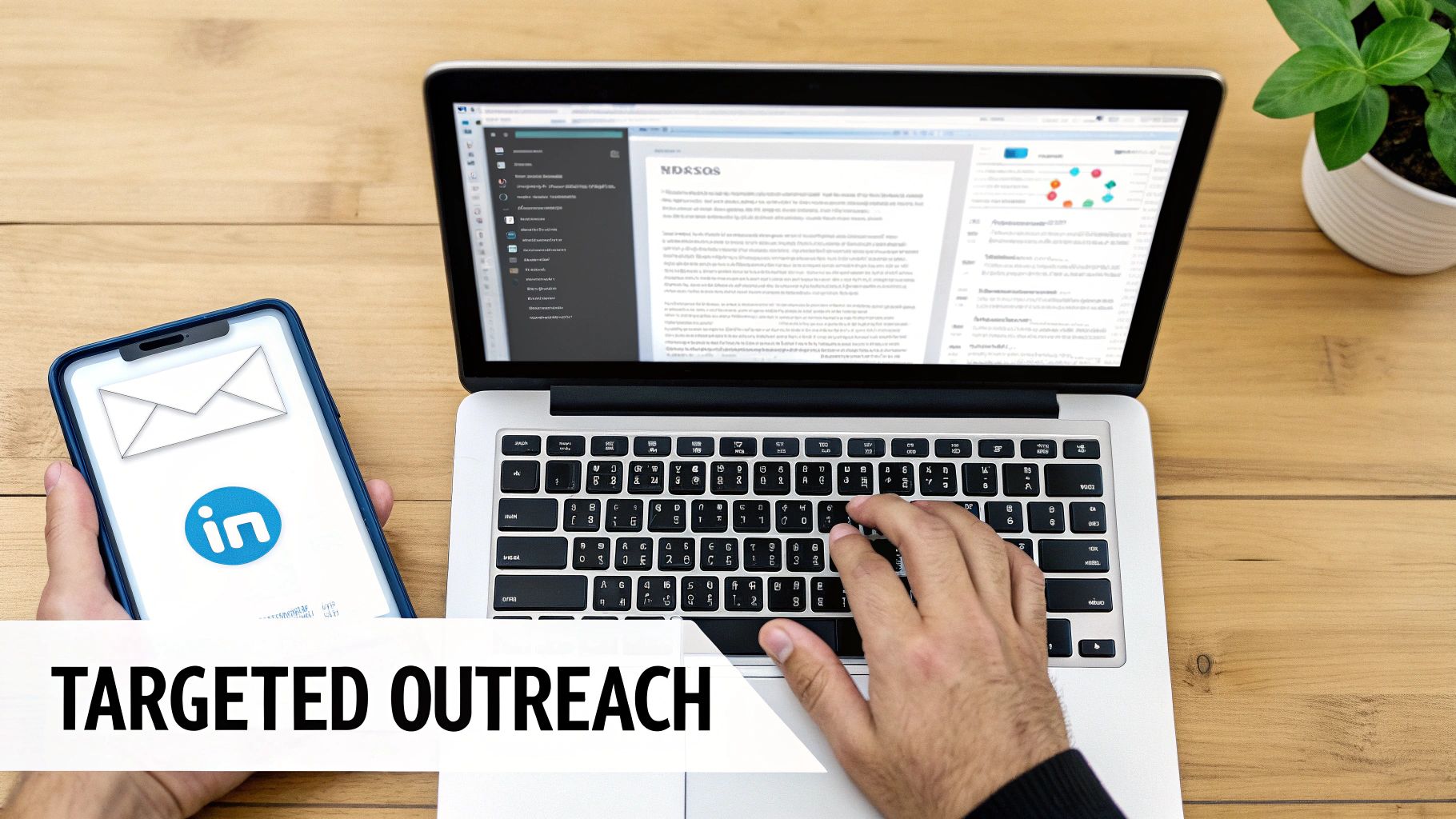
Think of it as a "push" tactic, but one with a clear purpose. It's about spotting high-potential accounts, identifying the key decision-makers inside them, and starting a conversation that offers real value right from the start. The game has shifted from quantity to quality, ensuring every message is relevant and respects your prospect's time.
Crafting Outreach That Cuts Through The Noise
The secret to outbound that actually works? Personalization. Generic, mass-blasted emails are dead on arrival—they go straight to the trash folder. A winning campaign kicks off with solid research into a prospect's company, their role, and the specific challenges they're facing.
Your first message, whether it’s a cold email or a direct message, needs to feel like it was written just for them. It has to show you've done your homework and have a solution for a real pain point. Instead of jumping straight to a sales pitch, offer something valuable—a helpful resource, a relevant insight, or a proposal for a quick, high-value chat.
LinkedIn is a goldmine for this. It plays a massive role in B2B, with 40% of B2B marketers calling it their most effective channel for sourcing high-quality leads. Features like Lead Gen Forms are incredibly powerful, hitting a 13% average conversion rate, which blows the typical landing page average of 2.35% out of the water. You can learn more about how LinkedIn powers B2B connections in detail.
Implementing Account-Based Marketing For Precision
Account-Based Marketing (ABM) is the ultimate form of targeted outbound. Instead of casting a wide net, ABM treats each high-value account like its own market. It’s a coordinated attack, with your sales and marketing teams working together to engage specific companies.
A solid ABM campaign might include:
- Personalized Content: Building landing pages or case studies that speak directly to a target company’s industry and pain points.
- Targeted Ads: Running ad campaigns on platforms like LinkedIn that are only shown to employees at your hand-picked accounts.
- Coordinated Outreach: Making sure sales reps, marketers, and even executives are all on the same page with their messaging to key stakeholders.
Mini Case Study: A SaaS company was targeting enterprise retail clients. Using LeadSavvy Pro, they identified VPs of Operations at five of their dream companies. Their ABM campaign involved sending personalized video messages on LinkedIn, followed by a targeted email sequence that referenced a recent industry report. This hyper-focused approach landed them three product demos in just two weeks, proving that precision outreach delivers big results.
Putting AI to Work for Smarter Lead Generation
The future of lead generation is already here, and it’s all about working smarter, not harder. Technology is completely changing how we connect with customers. We're moving away from old-school manual tasks and into intelligent, automated systems that can almost read a customer's mind.
Artificial intelligence (AI) isn't just a buzzword anymore; it's a real, practical tool you can plug right into your B2B lead generation strategy. AI-powered platforms can sift through mountains of data to pinpoint which prospects are actually likely to buy. This frees up your sales team to stop chasing dead ends and start building relationships with people who are ready to talk.
The Power of Predictive Lead Scoring
One of the coolest things AI brings to the table is predictive lead scoring. Forget just tracking email opens. AI models look at everything—past customer data, company details, a prospect's online behavior—to give you a score that genuinely reflects how likely they are to become a customer.
This is what allows you to personalize your outreach without spending all day on it. An AI can spot that a prospect from a target industry just visited your pricing page for the second time, instantly flagging them as a hot lead for your team. Our guide on automated lead generation dives deeper into how these systems can fill your sales pipeline with quality leads.
AI helps you switch from a reactive "wait and see" approach to a proactive one. You can find and engage your ideal customers with a level of precision that just wasn't possible before.
Creating a Seamless Omnichannel Experience
Technology is also the key to creating a smooth, connected journey for your buyers through omnichannel engagement. This just means breaking down the walls between all your marketing channels—your emails, social media, website, and content—so they all work together as one cohesive experience.
Think about it from the buyer's perspective. They might see your brand on a LinkedIn post, click over to read a blog on your site, and then get a perfectly timed email about a webinar on that same topic. In an omnichannel setup, every touchpoint feels connected, gently guiding the prospect from one step to the next without any awkward gaps.
The results speak for themselves. Companies with a strong omnichannel game see engagement rates around 19%. Compare that to the measly 5.4% for businesses stuck with disconnected channels. That’s a massive 3.5-times improvement in effectiveness just from making sure everything works together smoothly.
Measuring The Metrics That Actually Matter
If you can't measure it, you can't improve it. This old saying is the absolute truth in B2B lead generation.
It’s easy to get distracted by flashy numbers like website traffic or how many likes your latest social media post got. But these are often just "vanity metrics"—they look good on a report but don't tell you if you're actually making money. To see what's really working, you have to dig deeper and track the key performance indicators (KPIs) that connect directly to your sales pipeline.
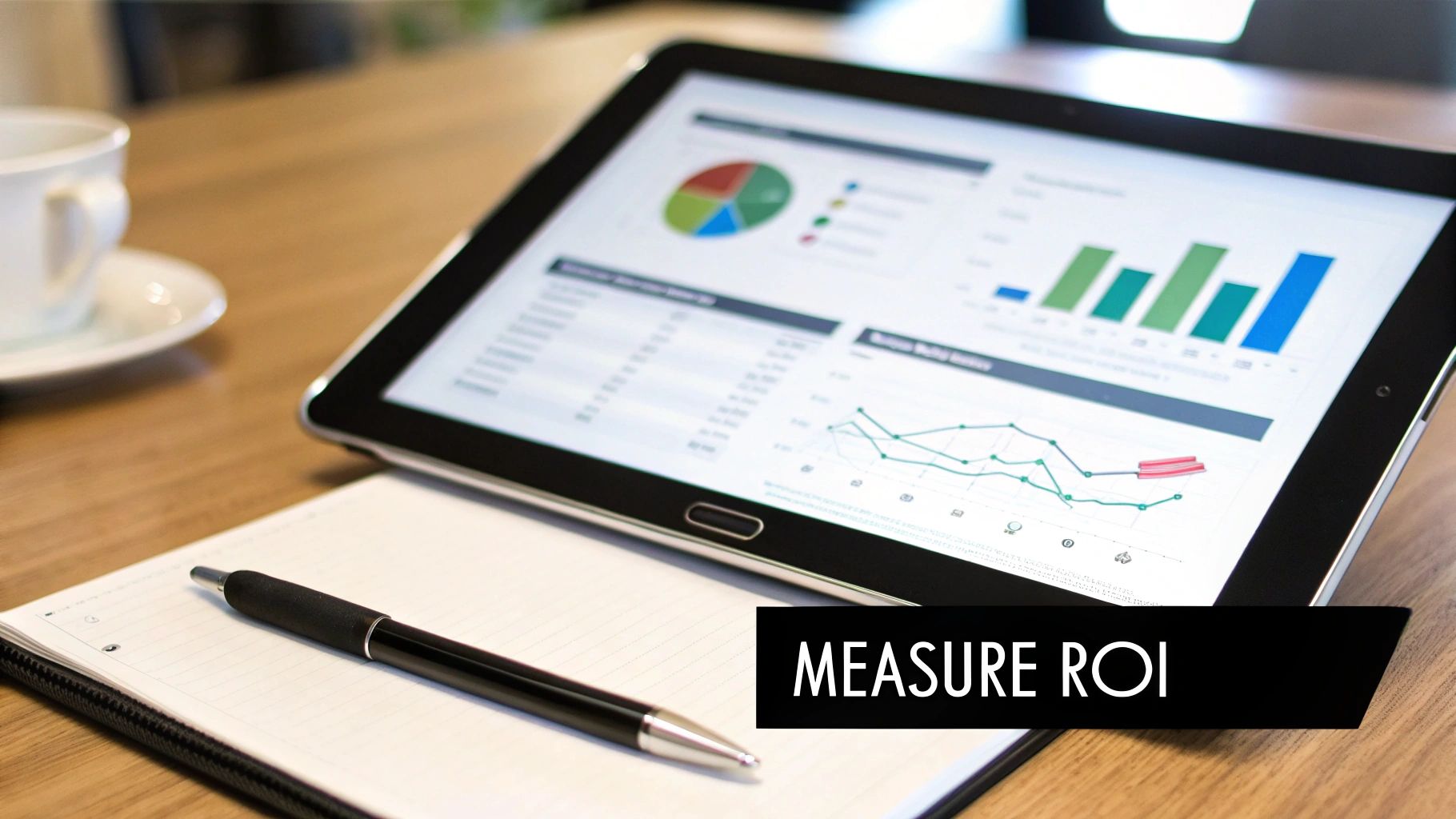
Tracking the right data is the difference between guessing and knowing. It’s the only way to figure out the true return on investment (ROI) from your campaigns and make smart decisions that consistently bring in better results.
Core Metrics for B2B Lead Generation
So, what should you be watching? Let's break down a few of the most essential metrics that go beyond just counting leads and focus on what really drives the business forward. For a complete list, check out our deep dive into the most important lead generation KPIs.
Here are the big three to start with:
- Cost Per Lead (CPL): This is your ground-level efficiency metric. It answers the simple question: "How much did it cost us to get one new lead?" Just divide your total marketing spend by the number of new leads you generated. A low CPL is a great sign.
- Customer Acquisition Cost (CAC): This metric takes it a step further. Instead of just a lead, it measures the total cost to land an actual paying customer. CAC rolls up all your sales and marketing costs, giving you a crystal-clear picture of what it takes to close a deal.
- Lead-to-Customer Conversion Rate: This percentage tells you how many of your leads eventually turn into paying customers. It's a powerful gut check on the quality of your leads and the effectiveness of your sales team's follow-up process.
By focusing on these core metrics, you shift the conversation from "How many leads did we get?" to "How much revenue did our efforts generate?" This financial clarity is essential for scaling your B2B lead generation strategy successfully.
A Few Common Questions About B2B Lead Gen
When you're getting into B2B lead generation, a few questions always pop up. Let's tackle some of the most common ones to give you a clearer picture as you start building out your own strategy.
How Long Does This Actually Take?
This is the big one, and the honest answer is: it completely depends on the path you choose. Some methods are a slow burn, while others can get the conversation started much faster.
- Inbound Plays: Think of things like SEO and content marketing as planting seeds. You're building an asset over time. You should expect it to take 6-12 months to really gain traction and see a reliable stream of leads coming in.
- Outbound Hustle: If you're doing targeted outreach, like personalized emails or hitting people up on LinkedIn, you can see responses much quicker. Sometimes within just a few weeks.
But no matter which route you take, building a predictable sales pipeline is a long-term game. It requires consistent effort, day in and day out.
What’s The Real Difference Between A Lead And A Prospect?
People throw these terms around like they're the same thing, but they represent two very different points in the journey. Nailing this distinction is key to managing your pipeline without going crazy.
A lead is basically anyone who has raised their hand, even slightly. Maybe they downloaded a whitepaper, signed up for your newsletter, or dropped their info in a contact form. They're at the very top of your funnel—interested, but not yet vetted.
A prospect, on the other hand, is a lead you've actually qualified. Your team has checked them out and confirmed they fit your criteria. They have the budget, the authority to make a decision, and a real need for what you're selling. A prospect is a serious potential customer who has moved down the funnel.
The whole point of lead nurturing is to turn that initial flicker of interest (a lead) into a genuine business opportunity (a prospect). It's all about building that relationship and confirming there's a real fit.
What Are The Biggest Mistakes I Should Avoid?
So many businesses stumble over the same hurdles when they're starting out. If you can sidestep these common pitfalls, you'll save yourself a ton of time and cash.
- Not Defining Your Ideal Customer Profile (ICP): If you don't know exactly who you're selling to, you're just shouting into the void. You'll waste all your energy on leads that were never going to buy anyway.
- Going Straight for the Sale: Let's be real, B2B buyers today can smell a sales pitch a mile away. Build trust by offering real value and helpful insights first. The sale will follow.
- Forgetting to Nurture: B2B sales cycles can be long. Very few people are ready to buy the first time they hear from you. You absolutely need a process to stay top-of-mind and guide leads along their journey.
Ready to capture leads and follow up before they go cold? LeadSavvy Pro syncs your Facebook leads directly to your CRM or Google Sheets, cutting out the manual work so you never miss a shot. Get started for free at leadsavvy.pro.

